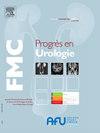Traitement d’une hypertrophie bénigne de prostate symptomatique chez un patient pris en charge pour un cancer de prostate localisé
Q4 Medicine
引用次数: 0
Abstract
Introduction
La coexistence d’une hypertrophie bénigne de prostate (HBP) et d’un cancer de prostate est fréquente, du fait de l’augmentation de prévalence de ces deux pathologies avec l’âge. Cette revue a pour objectif de faire une mise au point à la fois sur la prise en charge symptomatique et l’adaptation des traitements oncologiques, chez les patients diagnostiqués avec une HBP et un cancer de prostate.
Matériel et méthodes
Une revue de littérature a été effectuée sur la base de données PubMed, avec les mots clés « benign prostatic hyperplasia », « transurethral resection of the prostate », « prostate cancer », « radiotherapy », « enucleation », « HoLEP », « radical prostatectomy », « urolift », « prostatic artery embolization ». Un total de 76 articles a été retenu pour analyse.
Résultats
Plusieurs options thérapeutiques sont recommandées dans la prise en charge des cancers de prostate localisés. La prostatectomie totale représente une option thérapeutique qui peut permettre à la fois un traitement curatif des cancers de prostate localisés et une amélioration des symptômes obstructifs, au prix du risque d’incontinence urinaire en postopératoire. Dans le cas où une prise en charge par radiothérapie est retenue, la prise en charge des symptômes du bas appareil urinaire (SBAU) représente une priorité avant traitement oncologique. La RTUP représente l’option thérapeutique historique dans la prise en charge des SBAU en cas d’HBP, mais est associée à un surrisque de toxicité urinaire sévère et d’hématurie. Des études dédiées restent nécessaires afin d’établir des recommandations de haute qualité quant à la stratégie désobstructive optimale chez les patients devant recevoir une radiothérapie prostatique. Les chirurgies désobstructives à visée palliative permettent d’améliorer la symptomatologie obstructive chez les patients atteints d’un cancer de prostate, au prix néanmoins d’un risque d’échec d’ablation de sonde et de ré-opération plus élevés que chez les patients avec HBP. Les stratégies mini-invasives restent pour le moment expérimentales, à la fois chez les patients atteints d’un cancer de prostate localisé et localement avancé.
Conclusion
La prise en charge des SBAU chez les patients atteints d’une HBP et d’un cancer de prostate doit être effectuée de manière pluridisciplinaire et intégrer le stade du cancer, les objectifs du traitement oncologique, et l’espérance de vie globale du patient.
Introduction
The coexistence of benign prostatic hyperplasia (BPH) and prostate cancer is frequent, due to the increasing prevalence of both pathologies with age. The aim of this review is to provide an update on both symptomatic management and adaptation of oncological treatments, in patients diagnosed with BPH and prostate cancer.
Material and methods
A literature review was performed on the PubMed database, using the keywords “benign prostatic hyperplasia”, “transurethral resection of the prostate”, “prostate cancer”, “radiotherapy”, “enucleation”, “HoLEP”, “radical prostatectomy”, “urolift”, “prostatic artery embolization”. A total of 76 articles were selected for analysis.
Results
Several treatment options exist for the management of localized prostate cancer. Radical prostatectomy represents a therapeutic option that can allow both curative treatment of localized prostate cancer and improvement of obstructive symptoms, but is associated with a risk to develop urinary incontinence. In case of radiation therapy, lower urinary tract symptoms (LUTS) should be managed before oncological treatment. TURP is the historical treatment option for LUTS in men with BPH but is associated with an increased risk of severe urinary toxicity and hematuria. Dedicated studies are still needed to determine the optimal strategy in patients undergoing prostatic radiotherapy. Palliative surgery can improve obstructive symptomatology in prostate cancer patients, but at the cost of a higher risk of failure of the initial voiding trial and reoperation than in patients with BPH. Minimally invasive strategies remain experimental, both in patients with localized and locally advanced prostate cancer.
Conclusion
The management of LUTS in patients with BPH and prostate cancer must be multidisciplinary, integrating cancer stage, oncological treatment goals, and the patient's overall life expectancy.
局部前列腺癌患者良性前列腺肥大的治疗
良性前列腺肥大(BPH)和前列腺癌的共存是很常见的,因为随着年龄的增长,这两种疾病的发病率都在增加。本综述的目的是阐明诊断为HBP和前列腺癌的患者的症状管理和肿瘤治疗的适应性。装备和méthodesUne文学杂志上进行了PubMed数据库,与关键词的«善意prostatic hyperplasia»、«transurethral resection of the前列腺癌症前列腺»、«»,«radiotherapy»、«enucleation»、«HoLEP prostatectomy激进»、«»、«urolift»、«prostatic artery embolization»。共选择76篇文章进行分析。结果在局部前列腺癌的治疗中推荐了几种治疗方案。全前列腺切除术是一种治疗选择,既可以治疗局部前列腺癌,也可以改善阻塞性症状,但代价是术后尿失禁的风险。在选择放疗的情况下,低尿道症状的管理是癌症治疗之前的优先事项。RTUP是HBPs治疗SBAU的历史治疗选择,但与严重尿毒性和血肿的风险增加有关。仍然需要专门的研究来为接受前列腺放疗的患者提供高质量的最佳治疗策略建议。姑息性去阻塞性手术改善了前列腺癌患者的阻塞性症状,但其代价是导管消融失败和再手术的风险高于HBP患者。微创策略目前仍在局部和晚期前列腺癌患者中处于实验阶段。结论HBP和前列腺癌患者的BAU管理必须多学科进行,包括癌症阶段、肿瘤治疗目标和患者的总预期寿命。良性前列腺增生(BPH)和前列腺癌的并发是很常见的,因为随着年龄的增长,这两种疾病的发病率都在增加。本综述的目的是提供BPH和前列腺癌患者的症状管理和肿瘤治疗适应的最新情况。使用关键词“良性前列腺增生”、“经尿道前列腺切除”、“前列腺癌”、“放射治疗”、“核增生”、“HoLEP”、“根治性前列腺切除术”、“urolift”、“前列腺动脉栓形成”在PubMed数据库上进行了文献综述。共选择76篇文章进行分析。结果有几种治疗方案可用于管理局部前列腺癌。根治性前列腺切除术是一种治疗选择,既可以治疗局部前列腺癌,也可以改善阻塞性症状,但与发展尿失禁的风险相关。在放射治疗的情况下,低尿道症状(LUTS)应在肿瘤治疗前管理。TURP是BPH患者LUTS的历史治疗选择,但与严重尿毒性和失血风险增加有关。在前列腺放疗患者中,还需要专门的研究来确定最佳策略。姑息治疗可以改善前列腺癌患者的阻塞性症状,但其代价是,与BPH患者相比,初始导管试验失败和再手术的风险更高。在局部和局部晚期前列腺癌患者中,微创策略仍处于实验阶段。结论BPH和前列腺癌患者的LUTS管理必须是多学科的,整合癌症阶段、肿瘤治疗目标和患者的总预期寿命。
本文章由计算机程序翻译,如有差异,请以英文原文为准。
求助全文
约1分钟内获得全文
求助全文

 求助内容:
求助内容: 应助结果提醒方式:
应助结果提醒方式:


